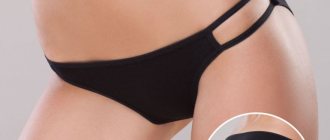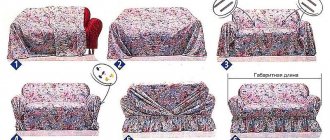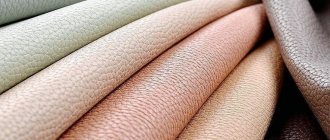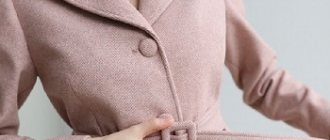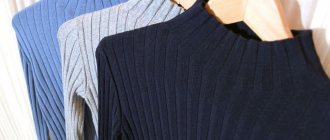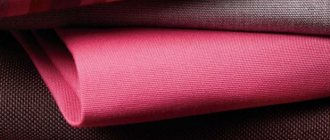As a rule, it is made from synthetic materials: nylon, silk, lycra, as well as elastane and other mixed fabrics. The most popular are flesh-colored and black tights, as an element of the dress code.
“The density and elasticity of a thread is measured in denier: the higher the denier, the denser the material. The denier number refers to the weight in grams of a kilometer long thread. (40 den means that 9 km of tights thread weighs 40 g.) Also sometimes the density of tights is measured in DTEX units. There are also tights that retain heat - thermal tights.” Wikipedia
What are they?
After World War I, women's fashion began to gradually change. Long dresses and skirts were replaced by short items. Stockings have become not just a luxury, but a necessity. They had to be durable, comfortable and beautiful. At that time, the only material that satisfied these requirements was silk.
Initially, stockings were held on ladies' legs using garters. At the beginning of the 20th century, they began to be attached to belts. But women's tights themselves appeared thanks to tap dancing. They were invented by an American actress and dancer named Ann Miller. The fact is that this girl danced masterfully. She moved so fast that neither stockings nor garters could stay on her feet. At first, Anne simply sewed them to the belt, but this was inconvenient. Thin products quickly tore, which greatly hampered the performance. It was necessary to tear off the stocking from the belt, replace it with a new one, and then sew it on again. This took too much time. As a result, the dancer combined a belt and stockings, which is how the first tights appeared in the world.
Nylon tights came into mass production only in 1961 thanks to Allen Ghent, a manufacturer from America. At first, products were made from durable knitwear; they appeared on the shelves in 1959. 2 years later, Allen released thin nylon stockings. The product was enthusiastically accepted by women. Many years have passed since then, but nylon tights are still popular. Their advantages:
- beautifully complement the image of a woman;
- correct skin tone;
- make the outline of the legs more graceful;
- protect from cold and wind;
- some models have a healing, massage effect.
Beautifully complement the image
Correct skin tone
Makes the contours of the legs graceful
Protects from cold and wind
It is difficult to understand the assortment presented today. To do this, you need to know the features of using tights:
- Nude stockings are not in fashion now; matte stockings are in demand.
- The shade should be close to the natural skin color.
- You should not try to imitate a tan on your legs with tights.
- It is advisable that the stockings are 8-10 denier, no more, then they will be invisible on the legs.
Stockings and sandals are incompatible things. Even the thinnest tights can only be worn with shoes. It should be remembered that when the camera flashes, any nylon products will shine; it looks unaesthetic.
Matte products are in fashion
The shade must match the skin color
You can't fake a tan on your legs with tights
To make tights invisible, choose 8-10 den.
What are tights made of?
Until recently, tights or stockings were mostly knitted. Previously, stockings were made from velvet, silk or linen. American dancer and actress Ann Miller asked to make tights for her. However, they became popular 20 years later, with the advent of short skirts that could not be combined with stockings.
You can buy tights that exist now, as a rule, from synthetic fibers. The most basic components are elastane and polyamide. In addition to synthetic threads, tights may contain wool, cotton, bamboo and viscose. In this article we will look in detail at the two main components of tights: polyamide and elastane.
Polyamide: history of origin and main properties Polyamide is a type of plastic that is used in various industries. These high-molecular compounds can be found in medicine and the automotive industry, mechanical engineering and the national economy. Sausage casings and thread for tights are made from polyamide.
One of the most famous polyamides used in the textile industry was nylon. It was possible to obtain a new synthetic fiber in the DuPont laboratory in 1935. However, the public learned about this invention almost three years later. Typically, the names of chemical compounds are formed from the chemical formula. However, “nylon” is an artificially created name. There are several versions. One of which - the name - is an abbreviation of two large cities, New York and London. Nylon is not the first development of the company. It was originally created for the production of gunpowder.
However, the invention of nylon created a sensation. It was this synthetic fiber that made it possible to produce thin and transparent stockings. And although the stockings of those years cannot be compared with modern ones, this invention was of great not only scientific, but also practical significance. Main characteristics: strength and thinness. When advertising this invention, a comparison was made between steel and spider webs as strong evidence of the strength and thinness of the material.
Another well-known polyamide fiber, created around the same period, but in Germany, was perlon, and later - dederon. And at the end of the 40s, nylon was created in the Soviet Union. It is also durable, elastic and is widely used both in the textile industry and in everyday life.
Thus, gradually, synthetic fiber is becoming indispensable in the textile industry. This happened due to two main aspects: 1. The cost is much cheaper than natural fabrics and yarns. 2. Some properties that synthetic fibers possess are an order of magnitude higher than natural ones. For example, using synthetic threads you can create a denser fabric than using natural ones. And the wear resistance is much higher. All this has led to the fact that the share of synthetic fibers in the textile industry today is about 60%. Initially, polyamide is obtained by processing petroleum products. First, natural raw materials are processed. Then the raw material is heated, threads are formed, and cooled. And the last stage is textile processing, where the thread is twisted to create yarn. Polyamide fibers can be subjected to additional processing, the purpose of which is to give the finished fiber additional characteristics, such as softness, increased strength, less electrification, and so on. Therefore, the cost of threads can be judged by their thickness. As a rule, the thicker the thread, the more expensive it is. Although, a thicker (expensive thread) will at the same time be softer and stronger. Thread density is measured in den.
Over the next decades, scientists who worked to improve synthetic fibers tried to create microfibers not only from polyamide, but also from polyester. The first microfiber was introduced by Japan in 1976. Microfiber, which is widely popular now, appeared much later.
Microfiber is a yarn created from many polyamide filaments. If we compare the thickness of microfiber with silk, then silk thread is twice as thick, and human hair is five times thicker. Thanks to the special manufacturing technology of these threads, microfiber characterizes the finished product as soft and silky. Tights with microfiber have increased comfort and are practical. What properties do tights containing polyamide have? They are soft and durable, light and silky, they are abrasion resistant, do not absorb moisture and dry quickly. After washing there will be no shrinkage or pilling. The tights do not need ironing as they do not wrinkle. If you wish, you can repaint them a different color. If polyamide fiber is part of a product that contains cotton or wool, then thanks to the synthetic fiber the product gains strength.
Do not overstretch the product; it may become slightly deformed. Synthetic fiber is not resistant to solvents. Do not wash in hot water or boil, as a number of properties are lost when heated. Recommended temperature for washing is up to 40 degrees. If you decide to machine wash, you should choose a delicate wash, and place the product in a special bag. When washing by hand, the use of a bag is not required. Dry a wet product away from sunlight and away from the radiator. Do not iron and store away from sunlight.
If you pay attention to the composition of the product, then you should take into account that if the composition includes microfiber, this does not necessarily have to be reflected on the packaging. Some manufacturers try to emphasize this, while others limit themselves to indicating polyamide in the composition. All kinds of allergic reactions, including itching and redness after wearing tights, in very rare cases, can be associated with synthetic fibers. As a rule, if such a reaction occurs, then the culprit is low-quality dyes that provoke the body to such a reaction. To prevent this from happening to you, try to choose products in specialized stores or departments, as well as products from well-known manufacturers. You can also buy tights in branded boutiques of famous brands. Agree that if you do not consider your skin to be overly sensitive, and this has not happened to you before, then most likely you purchased a fake. Do not buy tights in places of spontaneous sales, in markets or secondhand. Tights and elastane: what do they have in common? The role of elastane is that it allows tights to stretch. Polyurethane elastic thread is an essential component of any tights. The elastane content can range from 3 to 30 percent. It should also be noted that the first to start producing polyurethane threads were the Americans in 1958. That is why they are leaders in this area. The name they gave to polyurethane threads became spandex. In fact, this is what they still prefer to call these elastic threads in North America.
Four years later, Europeans began to produce polyurethane threads. But they gave it a different name - elastane. In Russia, elastic spandex threads began to be produced only in 1975, 17 years after production in the USA. Beautiful and elastic tights, which were produced in America and Europe, were unavailable to Soviet women for a long time.
The quality and quantity of spandex (elastane) is an important factor in determining the cost of tights. Polyurethane threads are a fairly expensive fiber that allows tights to look impressive on the leg, fitting it in shape. Frequent washing and constant wear of this product, as a rule, does not affect the preservation of its shape. Also, the high elastane content in tights helps prevent snags and snags.
The technology for knitting elastane in a product varies, which ultimately affects the cost of tights. The simplest and most affordable method of application is to knit spandex (elastane) thread in even rows. If you look at the product from close distance, it will be noticeable.
More expensive models of tights use a so-called spun thread. This name is due to the fact that a polyamide thread wraps around an elastane thread. The wrapping can be either single or double. This technology for making tights gives the product a silky and smooth feeling. At the same time, this model will have greater strength.
The most expensive use of elastane in tights is one in which the product stretches evenly in three directions. This is the so-called 3D technology, in which an elastane thread is knitted in each row. The resulting structure of the finished product is dimensional stable. Fitting the entire length of the leg, the tights repeat all the anatomical features. Tights, made using 3D technology in combination with microfiber, are called “second skin” for their elasticity and softness.
The elasticity of the finished product directly depends on the percentage of elastane. The minimum amount is about 3%. As a rule, such products do not stretch well. In models of low and medium density, the content of elastic fibers increases to 10-12%. Premium tights contain twice as much elastane. A large number is possible in tights using 3D technology or compression. Compression underwear (support) is necessary to create a therapeutic effect for the treatment and prevention of various diseases, including varicose veins. Elastane is also a synthetic fiber. Thanks to him, we have elastic tights. Today, products containing lycra are very popular. It should be noted that Lycra is not a different synthetic fiber from elastane or spandex. This is a trade name (brand) of elastane, which was developed by the famous company DuPont. If you look at the packaging, it usually states the percentage of elastane rather than lycra.
The use of elastane in tights can be compared to the second important development of the twentieth century in the textile industry. This fiber contributed to the improvement of hosiery. It is this component that is responsible for the fit and stretchability, for the ability to retain the shape of the product well even after many washes. As a result, they are more practical.
Basic properties of elastane
There is a certain similarity between synthetic elastane fibers and rubber. One of the most important characteristics for this material is the ability to increase the size several times, which exceeds the original length due to stretching. Today you can find many trade names for elastane. This is due to the fact that large textile manufacturers patent their synthetic elastane fibers, thereby creating new brands. The main indicator is still extensibility. So, for example, lycra can increase the length by 6-7 times, dorlastan - 4-4.5 times, and creora - by 10-12.
Product classification
There are different types of tights. They are divided into varieties according to the number of deniers, Tex, material of manufacture, and additional parameters. There are products for girls, pregnant women, and children. Special mention should be made of options for ladies suffering from varicose veins.
By number of DEN
The density of tights is measured in deniers. This indicator is influenced by the quality and quantity of fibers used in the manufacture of products. Information on density can be found on the product packaging. Classification of tights by category:
- 5–9 den – thin, transparent, light, they are completely invisible on women’s legs. They are worn even in the summer, for example, if the dress code requires it. Suitable for evening wear.
- 10–15 den – slightly more durable products. Designed for the warm season.
- 20-40 den are practical stockings that can be worn in spring or on a cool summer day. They are considered an attribute of office style.
- 40–60 den – tights intended for off-season wear.
- 80–100 den are the most durable products. Designed for use in winter, in cold weather.
In addition, especially dense products in 120–200 denier are available for sale. A woman will not freeze in them even in a snowstorm. When making tights with a density of 70 den or more, cotton, microfiber or wool are added to the silk fibers.
The number of deniers measures the density of the tights' fibers - the higher this indicator, the warmer and stronger the stockings. Products up to 20 denier are absolutely transparent. The higher this number, the more impenetrable the tights are. This value also affects the service life of the products.
On the packaging of tights you can often see dens written as a fraction, for example, 20/40, 40/70. A lower value indicates the density of the entire product, a larger value indicates the density of individual sections, heels, toes, and panties. Such models last longer because their weak points are stronger.
By TEX
Having figured out how many deniers there are in tights, you should pay attention to the TEX classification. Official documents indicate that these products are divided according to their purpose into women's and children's, and according to the manufacturing method - into cut, with sewing on the toe and seamless knitted. In addition, stockings are classified based on material and casting fiber density into:
- made from synthetic threads and threads;
- made from knitwear (hand or machine knitting).
There are also types of women's tights: medical, sports and household (dressy, everyday). According to the type of raw materials used, stockings are divided into:
- woolen;
- cotton;
- from synthetic and artificial fibers;
- half-woolen;
- from a mixture of threads.
TEX is an indicator by which the thickness of products is determined. It directly affects the transparency of stockings, their density, and ability to retain heat.
In addition, types of women's tights are divided according to the weaving method, finishing method, and sizes. Also, each manufacturer can introduce its own classification for products. For example, the Italian company Levante divides stockings according to the type of construction (with and without shorts), into products with a corrective (lifting) effect, winter, shiny, and mesh.
By purpose
By manufacturing method
Based on material and casting fiber density
Types of tights
By type of raw materials used
By type of material
Nylon tights can be made from different materials:
- Made from spandex and lycra. They produce high-quality products that fit exactly to the figure, are highly durable, pleasant to the touch, smooth and beautiful.
- Made from 3D lycra. It is used to make unique stockings that stretch in all directions. In other words, they are elastic both in length and width. They are characterized by maximum comfort, provide freedom of movement, and fit as if it were a second skin. Women note that it is almost impossible to leave puffs on the products.
- Made from microfiber. It produces dense, durable products that do not allow wind to pass through and retain heat. Girls say that such stockings do not wear out the heels and toes. These products are opaque, matte, suitable for wearing in winter.
- Made from polyamide. The material is used to make the cheapest tights, which are not of high quality. They can gather in folds on the legs, quickly tear and lose their appearance.
- From taktel. The material is a type of microfiber. Products made from it are very comfortable, velvety, silky, and windproof.
Stockings are made from textiles and are intended to be worn in the off-season and in winter. As always, their density is measured in denies. Products with a lower value are suitable for spring and autumn, while products with a higher value are suitable for extreme cold. They have a warming effect and are opaque in texture. If the composition includes wool, after washing the tights cease to be smooth, they become as if velvety, fleecy to the touch.
Spandex and Lycra
Lycra 3D
Microfiber
Polyamide
Tactel
Textile
By additional parameters
All tights offered to consumers are packaged in a certain way. Products available:
- In envelopes. They cost more than others, but they quickly smooth out on your feet.
- In boxes. The price of tights in this package is cheaper, but the products wrinkle a lot and you need to wait before they smooth out.
Among the types of tights, two types can be distinguished according to the level of fit. There are tall models that literally reach the navel, and low ones that sit on the hips. The fit is selected depending on the clothing. There are tights with a top in the form of panties or shorts, with or without a thicker sock. There are seamless models that are suitable for tight-fitting outfits.
In addition, there is a large selection of product colors, from the usual black and beige shades to extravagant turquoise or red. Tights can be decorated with different patterns. Lace and mesh inserts are in fashion.
It should be remembered that tights with prints do not suit business style; they are not worn to the office. Coco Chanel also introduced a rule regarding a small black dress - you only need to wear dark matte tights under it.
In envelopes
In boxes
High
Low
With patterns
Colored
Benefits of tights
Tights are a basic element of any woman’s wardrobe; as a rule, these clothes are available in various colors and for any weather. At the same time, tights have become part of the modern dress code; as a rule, these are black and flesh-colored products. We list other advantages of these products:
- maximum comfort and ease of wear (these products will not cause any discomfort even with daily use)
- modern models are hypoallergenic and hygienic (tights do not cause skin irritation and are absolutely safe to wear)
- high aesthetics (tights perfectly complement the image and add solidity)
- look great in any style and go well with both formal business style and many popular trends in clothing)
- good elasticity (due to this quality, high wear resistance and resistance to various physical and mechanical influences are achieved)
- tights are incredibly practical to use and can withstand repeated washing)
- long service life (with careful treatment, these products can retain their original appearance for a long time)
Specific types of tights
Some products cannot be classified into a certain type. These are the so-called specific types, for example, tights with a thermal effect, or modeling stockings. More details about them:
- Thermal tights are specially designed for wearing in the cold season. They consist of artificial and natural threads (wool, cotton, lycra, and so on). The products retain heat well and are impenetrable to wind. To avoid freezing even in severe frost, it is recommended to use them together with thermal underwear.
- Modeling stockings are designated body-shaping on the packaging. The products are created specifically to hide figure flaws. These tights are at least 40 denier, have a high rise, and shorts that flatter the stomach and buttocks.
- Support stockings, just like modeling products, are designed to correct a woman’s figure. Their density can reach 180 denier. On the packaging they are designated as up.
- Therapeutic and prophylactic products are designed to treat vein diseases, nail fungus, and cellulite. The threads from which they are made are impregnated with special compounds. Such tights can only be purchased at a pharmacy. On the packaging they are designated by the term claresse.
- Massage tights differ from other options in their dense texture, at least 40 denier. They help relieve fatigue from the legs and improve blood circulation. Recommended for girls who spend a lot of time on their feet. Made from lycra. The packaging is marked support.
Compression stockings are specially designed to treat varicose veins. Such products are marked with a cross on the packaging. There are 3 types of compression stockings. The first include options with a density of at least 70 denier; they are recommended for people leading a sedentary lifestyle and prone to obesity. The second type is intended for women with already developed varicose veins. They can also be worn by pregnant women. Still others are intended for girls suffering from varicose veins with trophic disorders. The density of these stockings can reach 280 denier.
Thermal tights
Body-shaping
Supporters
Treatment and prevention
Massage
Compression
What is included in women's tights
The main component of all types of tights is a chemical thread: acrylic and polyamide, to which elastane is added in different percentages for elasticity and firmness.
In addition to chemical threads, women's tights may also contain natural threads such as cotton and wool. These two types of fiber make tights more pleasant to the body, and, of course, warmer. But the appearance of such tights loses its elasticity and firmness; they often roll down, stretch out and lose their appearance.
The content of natural fibers in these products is about 3%, this is good because they will be more pleasant to the body and will not wear out so quickly.
How to choose
When choosing tights, you need to pay attention to many factors. Properly selected products will fit perfectly on the legs, hiding flaws and emphasizing the strengths of the figure. You need to pay attention to:
- Product density. The best tights for summer are up to 20 deniers, for the off-season – up to 60 deniers, for winter – up to 280 deniers.
- Composition of stockings. In order for them to retain their appearance even after several washes, up to 30% lycra should be used in their manufacture. Warm products almost always contain acrylic or microfiber.
- Size and comfort. In order to determine this value, you need to know your own parameters, namely height and weight. For girls up to 160 cm, up to 60 kg, XS is suitable, up to 70 kg and 170 cm - S, up to 80 kg and 175 cm - M, up to 85 kg and 185 cm - L, up to 95 kg - XL. If a woman is unsure about which size to choose, it is better to take a larger one than a smaller one. Products that are small, do not fit well on the legs, gather in folds, and tear.
- Gusset. She's always wearing good tights. With it, products fit better on the figure, last longer, and wear out less. In the most expensive models, this element is made of cotton.
- Seam quality. They should be practically invisible to the touch and visually. There are tights without any seams, but they are expensive. Round stitches are more common on budget models, but flat stitches are more common on more expensive ones. The latter do not rub and are invisible under clothes.
- Paint resistance to dry friction, sweat, washing. If low-quality dyes were used in the manufacture of tights, which is usually the case in cheap products, they will stain the leg. Unfortunately, it is impossible to check this factor without washing, so when purchasing, it is recommended to simply choose more expensive models from well-known manufacturers.
- Protection against puffs. Now there are types of tights that do not tear. Women are offered a choice of black or nude products, in 6 different sizes, with a density from 20 to 130 denier. Manufacturers claim that such tights can withstand up to 1000 washing cycles and do not stretch.
- Color. There are options not only for universal colors, but also in red, burgundy, brown, gray and others. Nude tights should be matched to your own skin color. Transparent black products are recommended to be worn only with modest outfits, without unnecessary details. Thick dark tights go with any clothes, but they are better combined with casual looks than with business clothes.
- Season. As mentioned above, you need to select stockings depending on their density. In summer it is recommended to spend as few days as possible, in winter – more.
Using the size chart when choosing tights is easy. The left column shows the woman’s height, the top line shows her weight. You should select your parameters, connect them together and see the size you need. For example, with a height of 170 cm and a weight of 70 kg, 4L is suitable.
Density of products, time of year
Composition, size and comfort
Color
Gusset
Seam quality
Package
Before choosing tights, you should pay attention to their packaging. It must be sealed without any signs of tampering.
It must contain the following information:
- full name of the manufacturer;
- his legal address and telephone number;
- size;
- density;
- color;
- compound.
If the above data is specified, then this indicates the reliability of the manufacturer.
The best manufacturers of tights are considered to be German and Italian.
In addition, you need to carefully study all the information about the product itself: the composition of the fabric, how to care for it and other important points that we will consider below.
How to care
In order to extend the life of your tights, you need to take proper care of them. To do this, the first thing you need to do is read the manufacturer's recommendations on the label. They cannot be neglected.
Nylon tights should be washed after each use. Among detergents, preference should be given to powders for delicate washing. Aggressive substances, which include bleach and alkali, should not be used.
As for the water, when washing by hand it should be lukewarm. When using an automatic machine, you just need to select the delicate wash mode and the minimum number of revolutions. The material from which nylon tights are made does not withstand high temperatures.
If you choose between automatic and manual washing, preference should be given to the latter. You can use regular liquid soap. It cleans products more delicately and does not leave streaks. Heavy stains can be removed with laundry soap.
In an automatic washing machine, tights should be washed separately from other items.
Wash after each use in warm water
When using an automatic machine, select the delicate mode and the minimum number of revolutions
Caring for tights
The tights are quite practical and not fussy to wear; they can easily withstand repeated washing. We will give basic recommendations that will help preserve all the qualities and good appearance of these products.
How to wash tights
Tights can be washed in a machine or by hand; machine wash is done on a delicate cycle, with liquid detergents, observing the temperature regime (no more than 30 degrees). A machine spin is acceptable, but at low and low speeds. This way you can preserve the shape and color of the product.
How to dry tights
After washing, it is best to dry tights in natural conditions, in a ventilated area, do not expose them to ultraviolet rays and dry them on a radiator. This may have a detrimental effect on the color and shape of the products.
The best models and manufacturers
All women wear tights, regardless of age and body type. This item is a must have in your wardrobe. When choosing, it is important not to make a mistake, to choose really high-quality products. To do this, you need to study the rating of tights.
For everyday wear
Among the best tights suitable for everyday wear are SiSi Be Free Vita Bassa 20 den, Omsa Attiva 40 den. SiSi is a famous Italian manufacturer of hosiery. It began its activities in 1925, but gained wide popularity only in the 1980s, when the company became part of a larger company - Golden Lady. Today it produces not only tights and stockings, but also knitwear, swimsuits and underwear.
SiSi Be Free Vita Bassa 20 den is a great option for summer and spring. Available in different colors. Advantages of tights:
- fits well, exactly according to the figure, does not bunch up on the legs;
- uniform color along the entire length;
- formed heel;
- imitation panties;
- durable.
- resistant to puffs;
- invisible padded toe;
- cost approximately 250 rubles.
Omsa is the most famous brand in the world market. People first started talking about the manufacturer in the 1960s in Italy. The company's products are famous for their interesting design and high quality. Omsa Attiva 40 den tights, available in 7 different colors, are suitable for everyday wear. The composition includes polypropylene (1%), elastane (11%), polyamide (88%). Among the advantages of the products, we should highlight the material, which is pleasant to the touch, stretches well, and is silky. The seams of the tights are flat and invisible under clothing. There is a high-quality gusset, thick socks and shorts.
SiSi Be Free Vita Bassa 20 den
Omsa Attiva 40 days
With a tightening and modeling effect
Among the types of tights with a slimming and silhouette-sculpting effect, the following should be highlighted:
- Pierre Cardin Toulon City line 40 den.
- Sanpellegrino Lift up Light.
- Conte X-press 40 den.
- Levante Body Slim 40 den.
Pierre Cardin is a world-famous French brand. The company's products are famous for their impeccable quality. In addition to stockings, the company sells perfumes, clothing, and various accessories. Pierre Cardin Toulon City line 40 den – tights with elastic pull-up panties 150 den. They make the silhouette more slender, tightening the sides and stomach. Other product advantages:
- cotton gusset;
- flat stitches;
- formed heels;
- transparent flat toes;
- The stockings are elastic and silky to the touch.
According to women's reviews, the tights fit exactly to their figure and do not fall off during wear.
Sanpellegrino is an Italian company known throughout the world. Produces hosiery products. Products from this company are famous for their high quality at low cost (within 300 rubles). Durable Sanpellegrino Lift up Light tights have a Push-Up effect, which is achieved through a wide elastic band that lifts the buttocks. Other advantages of the products:
- a thick elastic band at the waist that prevents the tights from sliding down when worn;
- high seating;
- 150 denier shorts (model the tummy and sides);
- durable toes;
- Available in 4 different colors.
Conte is a company from Belarus. It produces tights that are not inferior in quality to global manufacturers. In addition to stockings, it produces underwear. Conte X-press 40 den differs from other products of this brand in its tightening effect. They perfectly disguise the tummy and tighten the buttocks. Other benefits include:
- high shorts that do not pinch your figure;
- strength, protection against puffs;
- dullness.
The Italian company Levante began to conquer the market in 1991. Today it is one of the most famous brands offering hosiery products. Body Slim 40 den - tights with a slimming effect, which is achieved through tight 150 den shorts that shape the hips and stomach. Other advantages of the products: shaped heels, durable toes, matte finish, elasticity. Cost from 500 rubles.
Pierre Cardin Toulon City line 40 den
Sanpellegrino Lift up Light
Conte X-press 40 den
Levante Body Slim 40 den
Warm for autumn and winter
Among the insulated tights for girls, suitable for wearing in autumn, early spring and winter, we can highlight:
- Faberlic 200 den.
- Conte Cotton 400 den.
- Fute cashmere.
- Golden Grace Nord Voyage 300 den.
The name "Faberlic" is widely known in Russia. This is a popular manufacturer of skincare and decorative cosmetics, household goods, hosiery, accessories, and clothing. Produces classic, corrective, and modeling tights for pregnant women.
Faberlic 200 den – warm tights suitable for daily wear. Made from cotton. The cost is around 600 rubles. Among the advantages should be noted a durable toe, softness, pleasant to the touch surface. The lines are even and do not rub the skin. There is a wide elastic band at the waist that prevents the product from slipping when worn. Women note that even after a month of using tights every day, pills do not appear on them.
The Belarusian company Conte has already been written about above. Among others, it produces 400 den tights, which are made of 90% natural cotton. Product advantages:
- flat stitches;
- anatomical heels;
- padded toes;
- durable gusset;
- uniform color.
Fute is a well-known manufacturer from China that produces socks and tights. The company first appeared on the Russian market in the 90s. Fute cashmere is a comfortable tights made from 80% wool. They are distinguished by rich colors, wide and comfortable elastic waistband, and shaped heels. Other advantages: they fit well on the figure, do not bunch up on the legs, and are warm.
“Golden Grace” is a brand that became famous in Russia in 1993. It is engaged not only in its own production of goods, but also in the supply of products from Italy. Nord Voyage 300 den - smooth and warm tights, available in different, sometimes unusual colors, for example, a shade of bleached linen. The products are not inferior in quality to European brands. Their advantages include flat stitches and composition (70% cotton). The stockings are soft, pleasant to wear, durable, with a gusset. They have an original pattern - there is a braid on the sides.
Faberlic 200 den
Conte Cotton 400 den
Fute cashmere
Golden Grace Nord Voyage 300 den
Thin for summer
The range of thin tights suitable for summer is distinguished by its huge quantity and variety. The best models and manufacturers: Orodoro Cool Summer 8 den, Conte Elegant Summer Open Toe 8 den. Orodoro is a new Russian brand specializing in the production of tights, stockings, knee socks, and socks. Cool Summer 8 den – products designed specifically for wear in warm weather. They are very thin, they are not hot, the skin breathes. They have a barely noticeable pattern, similar in structure to a cut of wood. The tights are very light, almost weightless, and are not felt at all on the body. An amazing advantage is the cooling effect achieved due to the special weaving of the fibers.
Elegant Summer Open Toe 8 den tights from the already mentioned Conte brand have an interesting feature - open toes. Among the advantages of the products are a cotton gusset, a wide belt, and flat stitches. The stockings are very thin and completely invisible on the skin. Available in beige and transparent models.
Choosing good tights is not easy. To do this, you need to study a lot of recommendations, know trusted manufacturers and popular models. And the main thing is to try and focus on your own feelings.
Orodoro Cool Summer 8 day
Conte Elegant Summer Open Toe 8 den


